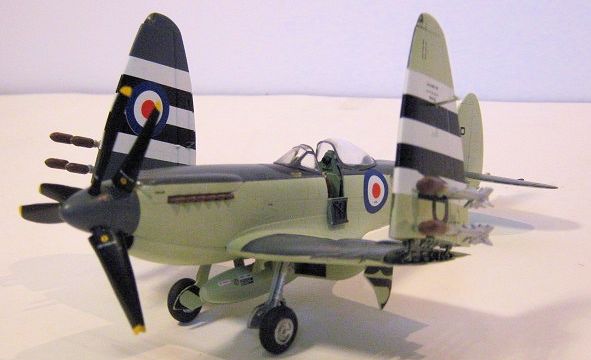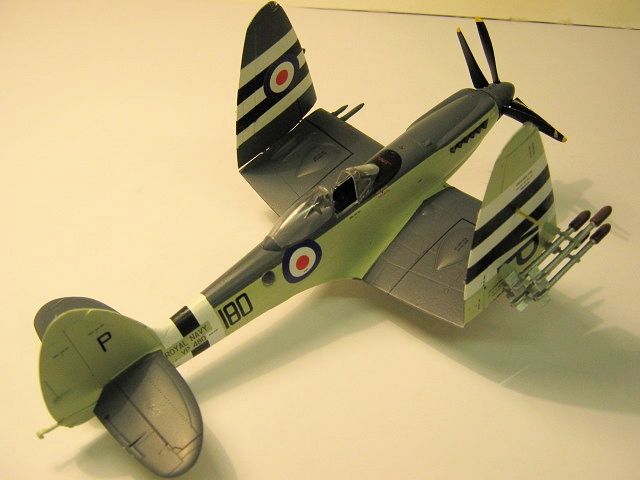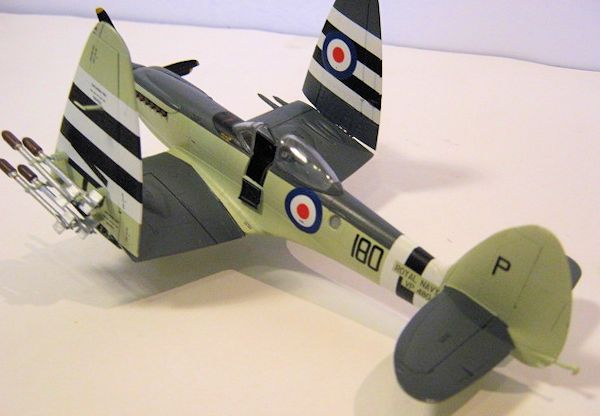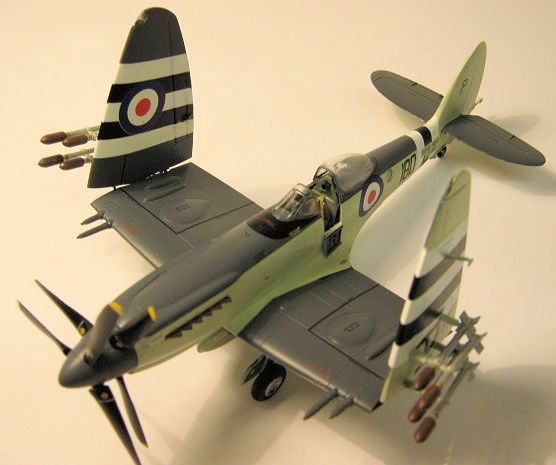
Airfix 1/48 Seafire FR.47
| KIT #: | A06103 |
| PRICE: | Around £18.99 |
| DECALS: | Two options |
| REVIEWER: | Frank Reynolds |
| NOTES: |

| HISTORY |
 46 was little more than a semi-navalised, hooked, Spitfire 24 that, having a
non-folding wing, was mainly limited to shore based service with training units.
46 was little more than a semi-navalised, hooked, Spitfire 24 that, having a
non-folding wing, was mainly limited to shore based service with training units.
The Seafire 47 is the last and surely best of the Spitfire/Seafire line. It had
yet another variation of wing form, with the outer panels folding to a near
vertical position for shipboard storage. Yet this most powerful, most capable
version of all is somehow close to being a footnote in history.
It first flew in April 1946, entering
service in 1948. At the dawn of the jet age, it was on the verge of
replacement when fate thrust it into the front line on the outbreak of the
Korean War in June 1950. The air group of the Royal Navy’s carrier HMS Triumph
would become heavily engaged in fleet defence and ground attack in a fast moving
war that stretched resources to the limit. The intensity of operations took a
heavy toll of all the front line and reserve Seafires in theatre. By
mid September 1950 the HMS Triumph
disengaged for return home with just three airworthy Seafires remaining, the
rest honourably worn out
Contemporary reports say that with its contra rotating propeller cancelling out the effects of torque and a reasonable view from its bubble canopy, the Seafire 47 was more straightforward to deck land than earlier Seafires although the swollen nose housing the mighty Griffon engine was a handicap.
| THE KIT |
In the 1990s
Airfix caused a minor
modelling sensation with the release of two kits in 1:48 scale – the Spitfire
22/24 and Seafire 46/47.
 22/24 and the third frame is of parts
to provide all of the variations applicable to the Seafire 46/47; being a whole
new folding wing for the ’47, contra prop components, centre line and under wing
slipper tanks. The clear parts frame contains both types of windscreen
applicable to Spitfire and Seafire variants. This either/or packaging represents
a subtle change from earlier boxings of the kit that I have in my collection, in
that previously the Spitfire 5-blade prop was omitted from the Seafire kit. What
we now have is a complete set of parts included in the box for a Spitfire 22/24
(less decals), which is welcome news for Spitfire nuts looking for a ready
source of the Spit 22/24 at non-collectors prices.
22/24 and the third frame is of parts
to provide all of the variations applicable to the Seafire 46/47; being a whole
new folding wing for the ’47, contra prop components, centre line and under wing
slipper tanks. The clear parts frame contains both types of windscreen
applicable to Spitfire and Seafire variants. This either/or packaging represents
a subtle change from earlier boxings of the kit that I have in my collection, in
that previously the Spitfire 5-blade prop was omitted from the Seafire kit. What
we now have is a complete set of parts included in the box for a Spitfire 22/24
(less decals), which is welcome news for Spitfire nuts looking for a ready
source of the Spit 22/24 at non-collectors prices.
The parts appear fairly cleanly moulded with just a trace of flash around some
of the parts such as the rocket tails. Surface detail on the main components is
fine and subtle. This kit has been minutely analysed
over the two decades since it first appeared and there is evidence that the
propeller blades have an incorrect profile, that the lower nose profile of
the’47 version is too deep and that the rear canopy is too short and too low in
profile. These are not major flaws in my opinion and the kit still builds into
an effective and convincing Seafire
Compared with Airfix’s new generation of Spitfires there are good and bad
points. The surface detail is arguably more delicate than newer offerings. By
contrast the cockpit detail is fairly basic and some details, such as the under
wing rockets are decidedly
clunky.
The instructions consist of a 16 page A4 style booklet with the 29 stages of
construction in a logical pictogram form. Two pages in colour set out the two
finishing options with paint colours keyed to the Humbrol range.
Decals
 Revised from the original kit release,
there is a choice of markings for the classical Seafire 47 in full Korean War
trim for 800 Naval Air Squadron on HMS Triumph in May 1950, with full
identification striping, or the option of an earlier 1950 finish without
stripes. The second main choice is new to this kit, being a land based Seafire
46 of the Station Flight, Lossiemouth, Scotland in 1948, in the standard scheme
of Sky under surfaces and Extra Dark Sea Grey uppers, relieved with a bright
yellow rudder and spinner.
Revised from the original kit release,
there is a choice of markings for the classical Seafire 47 in full Korean War
trim for 800 Naval Air Squadron on HMS Triumph in May 1950, with full
identification striping, or the option of an earlier 1950 finish without
stripes. The second main choice is new to this kit, being a land based Seafire
46 of the Station Flight, Lossiemouth, Scotland in 1948, in the standard scheme
of Sky under surfaces and Extra Dark Sea Grey uppers, relieved with a bright
yellow rudder and spinner.
The decal designers deserve credit for a thoughtful layout. Full black/white stripes are included on the sheet and the jewel in the package, where the massive under wing serial numbers are provided in two versions. Standard one piece decals can be used for a retracted undercarriage version but the serials are also supplied as four-piece units for each wing, comprising separate sections for the outer wing panels, the main gear doors, outer gear doors and wing centre section. The decals fit well to each component with a little help from some Micro Set, so it is goodbye to slicing the decals by hand for what can be a tedious job. There is a comprehensive set of stencils and wing walk stripes common to both versions and some 18 tiny decals alone to decorate the propeller assembly.
| CONSTRUCTION |
I elected to build almost straight from the box and the only aftermarket that I
used was a set of Eduard PE seat belts.
Flashed over holes in the fuselage sides and belly have to be opened up for the
camera ports and this is called out at the appropriate stage in the
instructions.
Construction is as straightforward as any
 standard Airfix kit. Some filler was
required along the main fuselage join seam, so there is just a hint that the
mould may be ageing slightly.
standard Airfix kit. Some filler was
required along the main fuselage join seam, so there is just a hint that the
mould may be ageing slightly.
| CONCLUSIONS |
 Time has been generally kind to this kit. It still builds well and the fit of
parts belies its age. For those who wish, there is scope to update and improve,
but for my money it is fine when built straight from the box.
Time has been generally kind to this kit. It still builds well and the fit of
parts belies its age. For those who wish, there is scope to update and improve,
but for my money it is fine when built straight from the box.
Standing in at position number 49 on my showcase shelves in my display of 50 or
so Spitfires and Seafires in 1:48 scale, this one works for me. Recommended for
its overall quality and at a bargain price.
| REFERENCES |
Spitfire, the History by Eric B. Morgan and Edward Shacklady, Key Publishing,
2000
On Target Profiles 5; Supermarine Seafire
Mk.1b – Mk.47 by Jon Freeman. Aviation Workshop Publications Ltd.
April 2013
If you would like your product reviewed fairly and fairly quickly, please contact the editor or see other details in the Note to Contributors.